
Leading the Pack
August 20, 2010
By
Heather Hager
In Sweden, evidence is everywhere that using biomass is part of daily life.
In Sweden, evidence is everywhere that using biomass is part of daily life. Those who made the trip to Jönköping for the World Bioenergy conference and exhibition this year had five full days of all things biomass, including pre- and post-conference tours and daily field trips to see biomass end-users in action. But in fact, the learning began even before the pre-conference tour commenced.
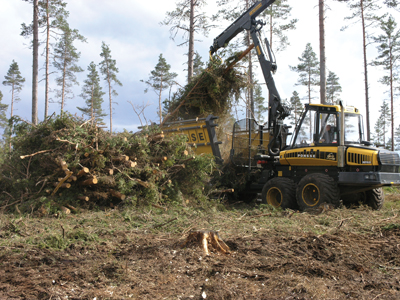 |
|
| Slash from forest thinning is collected and moved to piles at roadside, where it’s covered and left to dry.
|
For international participants, arriving at the Stockholm Arlanda airport was the first experience of bioenergy the Swedish way, although few may have known it. Most of the airport’s buildings are currently warmed on a biomass-fuelled district heating system. It’s allowed the airport to reduce its heating-related CO2 emissions to a whopping 95% lower than 1990 levels.
Barely a five-minute drive from the airport and we’d already passed several piles of slash and a pile of stumps drying by the roadside. These were likely destined for the local district heating plant. Slash piles by the roadside might seem unusual to visitors, but it’s merely a fact of life in a country where bioenergy became the largest single source of energy in 2009. At 31.7% of energy use, it was the first time that biomass surpassed all other forms of energy, including oil, hydro, nuclear, coal, natural gas, heat pumps, and wind (at 30.8, 16.9, 12.9, 3.3, 2.9, 0.9, and 0.7%, respectively), according to an analysis of Swedish Energy Agency statistics by the Swedish Bioenergy Association. Compare that to a lowly 8.6% of energy from biomass in Canada.
Massive Power
Electricity production in Sweden involves almost no fossil fuel, with only about 3% of mostly reserve capacity generation provided by fossil sources in 2008. The majority of electricity is generated from hydro, at 47%, and nuclear sources, at 42%. The remaining 8% is generated from biomass and recycled fuels at combined heat and power (CHP) plants.
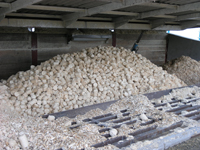 |
|
| The district heating plant at Malmköping burns chips, pellets, and these small briquettes.
|
“Combined heat and power plants are like the new cathedrals of Sweden,” remarked Kjell Andersson, our World Bioenergy pre-conference transfer tour guide. “They are now the largest buildings in many towns.” Our first stop on the tour was no exception: the Igelsta CHP plant, which happens to be Sweden’s largest. It’s owned by the municipalities of Södertälje, Botkyrka, and Huddinge under the Söderenergi company and began commercial operations a mere half-year previously in December 2009. It joins a functioning district heating plant at the site that began operating in 1982.
The Igelsta CHP plant produces 85 MW of electricity and 200 MW of heat, powering 100,000 and warming 50,000 homes. It takes a lot of biomass to fuel this plant – about 17,000 tonnes/week at full capacity and more than 400,000 tonnes/year – and every load is analyzed for fuel quality. “We had to expand the area of storage dramatically for the volume of biofuels,” said company spokeswoman Madeleine Engfeldt-Julin. The harbour at the site was expanded to accommodate two ships at once and receives about 200 shiploads/year. In addition, a fuel terminal was built at a nearby railway line located less than 50 kilometres from the plant. There, four trains/week each bring about 1,000 tonnes of biomass (equivalent to 30 truckloads) from forests in northern Sweden, meeting about half the plant’s fuel needs. Biomass is unloaded and stored at the terminal and later trucked to the plant.
This plant was designed to be fuel flexible, said Engfeldt-Julin. That allows Söderenergi to adapt to changes in fuel prices, scientific knowledge, and government regulations. The plant currently burns 75% wood chips and 25% recovered waste materials, comprising construction and demolition waste, non-recyclable plastics, and other combustibles.
This 250 million Euro investment is estimated to become profitable in 8–10 years because of green certificates, said Engfeldt-Julin. Under this system, electricity suppliers buy certificates according to their previous year’s sale and use of electricity.
Electricity producers using renewable energy sources receive a green certificate for each megawatt hour produced, gaining extra income for renewable electricity production.
Indeed, green certificates almost double the value of electricity from renewable sources, said the spokesman at the second CHP plant we visited. The plant, located in Nyköping, is owned by Vattenfall, a large, state-owned energy company. Its 100-MW CHP unit generates heat and 35 MW of electricity, and two additional boilers produce up to 80 MW of district heat. It burns about 170,000 tonnes/year of biomass, depending on the moisture content.
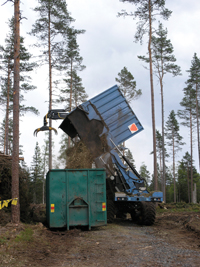 |
|
| The Bruks mobile chipper can access slash piles throughout the forest and bring the chips back to a waiting transport container. |
Originally a coal-fired plant, the fuel has been all biomass since 1991, but the composition—recycled wood, chips, sawmill waste, energy crops—changes with what’s most economical. Currently, it burns a lot of construction and demolition waste, more than half of which is imported by ship from places like Norway, Poland, the United Kingdom, and the Netherlands. The waste usually contains non-combustible material, so it’s first processed through a screen, crusher, and two large magnets, recovering on average one to two kilograms of magnetic material per tonne of waste. On-site storage capacity can fuel the plant for one and a half weeks at peak output, with three weeks of storage located five kilometres away.
Cities in North America that are running out of landfill space could take a lesson from Sweden. Swedish policy has banned combustible, non-recyclable waste from landfills since 2002, making it a valuable fuel source for CHP. One CHP plant in Linköping burns up to 420,000 tonnes/year of sorted waste from over 30 municipalities and recycling companies. Less than 5% of household waste in Sweden goes to landfill. Just think how much heat and power could be produced from Toronto, Montreal, or Vancouver’s garbage.
Community Heat
Although only a small proportion of total electricity production is from biomass, over 62% of district heating is fuelled by biomass, according to the Swedish Ministry of Enterprise, Energy, and Communications.
District heating is huge in Sweden and accounts for about 40% of the heating market, so we could hardly drive between Stockholm and Jönköping without stopping at several district heating plants, ranging from 2 to 6 MW. Although a far cry from the 200 MW of district heat put out by Sweden’s largest CHP plant, these smaller systems serve residences, municipal buildings, and industries in their localities.
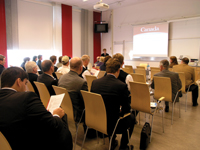 |
|
| A Canadian side event provided information about Canadian bioenergy opportunities and strove to link European businesses with partners in Canada. |
The smallest district heating system we visited, in Gränna, was in a building about the size of a single-car garage, dwarfed by two 80-cubic-metre silos containing wood pellets. That’s about a four-day supply for the 2-MW boiler in mild weather, we were told. The boiler is monitored remotely online, and a technician visits once a day during the workweek. This temporary, mobile plant, owned by Lantmännen Energi, is soon to be replaced by a permanent one. The company has about 15 similar heating plants throughout Sweden, which are handy in establishing an initial customer base and heating network in communities that lack such infrastructure.
Under the usual Swedish business model, one company (or municipality) owns the heat plant and another company owns the heating grid and distributes the heat. That’s not the case, however, in the small community of Malmköping, a town of about 3,500 inhabitants. There, two local entrepreneurs developed and own both the heat plant and the distribution grid, currently supplying 173 delivery points through five kilometres of pipeline. Customers pay a proportion of the cost to install pipeline to their residence and sign a five-year contract for heat. In turn, the company supplies the heat, owns the pipeline and residential delivery points, and provides equipment servicing.
The Malmköping plant was built with plenty of redundancy in case of breakdown. The 2- and 2.5-MW multi-fuel biomass boilers each have their own fuel storage silo and water distribution pump. In backup is a 3.2-MW oil boiler, as well as an electrical generator to run the system in case of power outage. The main fuel is briquettes from a sawmill less than 50 kilometres away. The silos are filled three times/week at peak winter production, and the plant burns about 2,700 tonnes/year of wood. The owners estimate that they could supply an additional 150 residences with this plant and are expanding into a new housing development.
The final district heat plant, at Skänninge, was actually shut down when we visited. One consequence of having CHP for electricity production is that there’s excess heat to get rid of in summer. Nearby communities that can tap into a CHP grid can take advantage of lower heating rates than they could produce themselves, which is what this community does. The Skänninge plant will fire up again in August, producing 6 MW of heat from wood chips, bark, and sawdust from local forests and sawmills within 100 kilometres.
Forestry Techniques
Once arrived at the World Bioenergy venue, participants had three mornings of informative presentations from international speakers. Afternoons, participants stretched their legs at the exhibition or on one of the daily excursions to see real bioenergy operations at work. Excursions included heat and power, biogas, biodiesel, wood pellets, solar-biomass combined energy, a biomass train terminal, and forest operations.
In Sweden, the forest harvesting slash isn’t considered waste—it’s a valuable product—so the forestry tour showcased some of the slash harvesting techniques used there. This demo took us to forest owned by Sveaskog, a state-owned company that’s Sweden’s largest forest owner, with 3.3 million hectares or 15% of Sweden’s productive forest. The company currently sells 1.4 million cubic metres of biomass and aims for 2 million cubic metres by 2013, according to biofuel coordinator Roger Johansson.
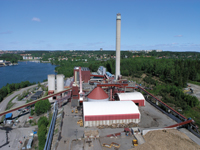 |
|
| This original district heating plant at Igelsta began operation in 1982 as a coal-burning plant and was converted to burn biomass beginning in 1994. |
Swedish forests are managed intensively throughout their lifespan. In a 20-year-old stand, a contractor was thinning the largest and smallest trees by multi-stem harvesting using a Log Max 4000 harvesting head on an Eco Log harvester. The roundwood was cut to length and sorted into pulpwood and energy wood for trucking to end-users, leaving the tops and branches to be collected and processed using methods such as chipping, bundling, or forwarding. In this case, a Ponsse 14-tonne forwarder with variable load space was collecting and transporting slash to small piles, to be covered by waterproof paper for six to nine months for drying. A Bruks mobile chipper completed the process, moving to the slash piles, chipping, and transporting the chips to a larger container at roadside, ready for delivery to a heat or CHP plant.
| Building Partnerships A big part of any conference involves networking and making new contacts. For this, the Canadian Trade Commissioner Service in Sweden organized an exciting side event, along with tasty hors d’oeuvres, that was a draw for Europeans and Canadians interested in forming or expanding bioenergy partnerships in Canada. Representatives from British Columbia, Ontario, and Quebec provincial governments talked about incentives and opportunities. Rolf Fyne, director of business development in Europe for Invest British Columbia, kicked off the session by listing why British Columbia is a great place to invest in bioenergy. The province aims to become a leading supplier of renewable energy throughout its region and to the nearby United States and is creating a policy environment to foster that, he said. Incentives include an estimated availability of 500–700 million bone-dry tonnes of beetle-killed wood by 2013, and carbon tax and carbon trading schemes that make bioenergy more profitable. Funding for research and development and demonstration projects is available under the BC Bioenergy Strategy, for example, and from the BC Bioenergy Network, said Fyne. And BC Hydro is soliciting renewable energy providers. Supportive policies and legislation include the Clean Energy Act of June 3, 2010; changes to boiler staffing requirements; a new ASME certification equivalency process for acceptance of approved European boilers; and the establishment of BC Timber Sales, which Fyne said is giving inexpensive, three-year contracts to remove beetle-killed wood and revitalize the forest. The Ontarians came armed with a menu of six real bioenergy partnership opportunities from companies based in Ontario or with assets there. And “there are more where those came from,” said Douglas Clarke, business development consultant for the Ontario Ministry of Economic Development and Trade in London, UK, and Stephen Roberts from the Ontario Ministry of Northern Development, Mines, and Forestry in Ontario. They also discussed ongoing and upcoming initiatives to stimulate forest bioenergy in Ontario, including the Green Energy Act, mandating an end to coal-fired electricity production by the end of 2014 and providing a feed-in tariff for renewable energy producers, as well as proposed forest tenure reform. Finally, Michel Lachance, director of industrial bioprocesses and bioproducts for Centre Québécois de Valorisation des Biotechnologies, described Quebec’s bioenergy goals and opportunities. The province aims to reduce greenhouse gas emissions by 20% from 1990 levels by 2020. This will be done partly by using the 6.4 million dry tonnes/year of available forest biomass, through programs that allocate residual forest biomass, support research and demonstration projects, and provide financial assistance for biomass heating to replace heavy oil consumption, for example. |
Print this page